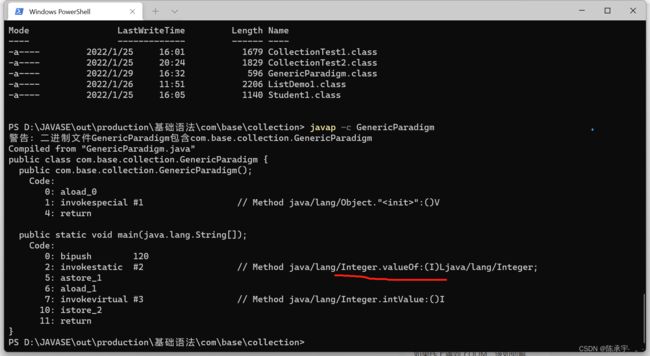Java自动装箱过程解析以及包装器valueOf源码
前言:
在学习JavaSE的时候遇到了一点问题,就是在自动装箱的时候,使用==号进行判断总是和预想的结果不太一样,所以自己就对自动装箱的过程进行反编译,查看一下具体调用的函数,然后再对相应的函数进行解读和实验。
正文:
我们的基本数据类型对应的包装器类如下:
| int | Integer |
|---|---|
| byte | Byte |
| short | Short |
| long | Long |
| float | Float |
| double | Double |
| char | Character |
| boolean | Boolean |
通过反编译我们可以发现实际调用的是valueOf的这个方法,于是我们到具体的包装器类中去查看valueOf这个方法的详细代码。
可以看到调用的是valueOf(int i)这个方法,这个方法的代码如下:
public static Integer valueOf(int i) {
if (i >= IntegerCache.low && i <= IntegerCache.high)
return IntegerCache.cache[i + (-IntegerCache.low)];
return new Integer(i);
}这个i相当于调入的函数: 我们来解读一下这段代码,相当于如果i大于等于low并且小于Cache里的high则不用创建一个新的对象,否则创建一个新的对象。
Integer包装器
IntegerCache方法代码如下:
private static class IntegerCache {
static final int low = -128;
static final int high;
static final Integer cache[];
static {
// high value may be configured by property
int h = 127;
String integerCacheHighPropValue =
sun.misc.VM.getSavedProperty("java.lang.Integer.IntegerCache.high");
if (integerCacheHighPropValue != null) {
try {
int i = parseInt(integerCacheHighPropValue);
i = Math.max(i, 127);
// Maximum array size is Integer.MAX_VALUE
h = Math.min(i, Integer.MAX_VALUE - (-low) -1);
} catch( NumberFormatException nfe) {
// If the property cannot be parsed into an int, ignore it.
}
}
high = h;
cache = new Integer[(high - low) + 1];
int j = low;
for(int k = 0; k < cache.length; k++)
cache[k] = new Integer(j++);
// range [-128, 127] must be interned (JLS7 5.1.7)
assert IntegerCache.high >= 127;
}
private IntegerCache() {}
}对于这几段的代码,我的理解是,如果 i>=-128&& i<=127 则不会创建一个新的对象。于是你就会发现下面这串代码神奇的地方:
public class GenericParadigm {
public static void main(String[] args) {
Integer a = 127;
Integer b = 127;
Integer p = new Integer(127);
Integer c = 129;
Integer d = 129;
System.out.println(a==b); //true
System.out.println(a==p); //false
System.out.println(c==d); //false
}
}所以自动装箱,有时候并不会创建一个新的对象,而只是让新的变量也指向相同值的地址,这一点需要注意。
Double包装器
Double 包装器的方法valueOf的代码如下:
public static Double valueOf(double d) {
return new Double(d);
}实际操作下来也是。
public class GenericParadigm {
public static void main(String[] args) {
Double a = 1.2;
Double b = 1.2;
System.out.println(a==b); //false
}
}Long包装器
Ps:在填入long参数的时候注意数字后面要加上L;
Long包装器中的valueOf方法:
public static Long valueOf(long l) {
final int offset = 128;
if (l >= -128 && l <= 127) { // will cache
return LongCache.cache[(int)l + offset];
}
return new Long(l);
}实验:
public class GenericParadigm {
public static void main(String[] args) {
Long a = 127L;
Long b = 127L;
Long p = new Long(127L);
Long c = 129L;
Long d = 129L;
System.out.println(a==b); //true
System.out.println(a==p); //false
System.out.println(c==d); //false
}
}Float包装器:
public static Float valueOf(float f) {
return new Float(f);
}所以实验效果和Double的一样。
Character包装器
valueOf源码:
public static Character valueOf(char c) {
if (c <= 127) { // must cache
return CharacterCache.cache[(int)c];
}
return new Character(c);
}实验:
public class GenericParadigm {
public static void main(String[] args) {
Character a = '你';
Character b = '你';
Character c = 'a';
Character d = 'a';
System.out.println(a==b); //false
System.out.println(c==d); //true
}
}Byte包装器
valueOf源码:
public static Byte valueOf(byte b) {
final int offset = 128;
return ByteCache.cache[(int)b + offset];
}从源码上看,就是无论如何他都不会创建一个新的对象。
Short包装器
valueOf源码:
public static Short valueOf(short s) {
final int offset = 128;
int sAsInt = s;
if (sAsInt >= -128 && sAsInt <= 127) { // must cache
return ShortCache.cache[sAsInt + offset];
}
return new Short(s);
}跟Integer和Long包装器一样。
Boolean包装器
valueOf源码:
public static Boolean valueOf(boolean b) {
return (b ? TRUE : FALSE);
}当然Boolean就只有true和false了;
总结:
总结如下:Short、Integer、Long包装器创建新对象的条件是小于-128或者大于127,Float、Double包装器自动装箱就会创建一个新的对象,而Character需要大于127才会创建一个新的对象,一般汉字就会超出127这个范围。Byte是不会创建一个新的对象的。
如果有什么地方写的不对,还请各位大佬指正
